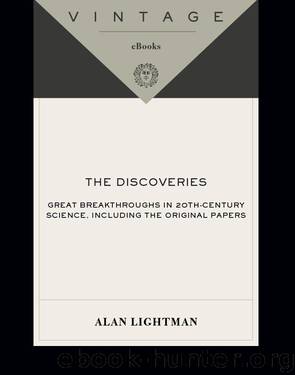The Discoveries by Alan Lightman

Author:Alan Lightman [Lightman, Alan]
Language: eng
Format: epub
ISBN: 978-0-307-48384-3
Publisher: Knopf Doubleday Publishing Group
Published: 2005-06-21T04:00:00+00:00
But the story was far from over. Although Fleming had discovered a powerful antibiotic, the substance had to be isolated, concentrated, and chemically purified before it could be of any medicinal use. And it had to be cured of its annoying property of fading after a week. Fleming was not a chemist. For these next chemical procedures, he enlisted the help of a young colleague in Wright's laboratory named Frederick Ridley. Ridley had not been trained as a chemist, but he knew more chemistry than anyone else in the lab. Ridley did not succeed.
On February 13, 1929, Fleming read his paper on penicillin to the Medical Research Club in London. The audience yawned. Not a single question was asked. Most biologists were still not convinced that it might be beneficial to put one germ into the body to kill another germ. And the charismatic Almroth Wright, who could have shaken up anyone to pay attention to a new idea, did not support this challenge from a former student. Finally, Fleming himself lacked the personality to forcefully champion his discovery. According to Sir Henry Dale, then chairman of the Medical Research Club, Fleming “was very shy, and excessively modest in his presentation, he gave it in a half-hearted way, shrugging his shoulders.”
For some time, Fleming's penicillin went largely unnoticed. Three other British chemists, Harold Raistrick, R. Lovell, and P. W. Clutter-buck, attempted to isolate and purify the active agent in penicillin. They also failed, because of the instability and delicacy of the substance. In particular, as Lovell later recounted, the three chemists did not realize that switching the pH over to the alkaline side at a crucial point would have allowed them to counter the deadening effects of ether in the extraction process. In 1934, still convinced of the potential therapeutic value of his mold, Fleming hired yet another biochemist, again without success. Languidly, Fleming continued to mention penicillin in his publications.
The difficult problem of chemically purifying and stabilizing penicillin needed more attention from the scientific community. And that attention, in turn, required a change in thinking about the viability of external antiseptics. Over the next five years such a transformation occurred—brought about in part by the limited success of the synthetic sulfonamide drugs and also by René Dubos's discovery of the antibacterial agent gramicidin. These new developments, as Fleming noted in his Nobel Prize lecture of 1945, “completely changed the medical mind in regard to chemotherapy of bacterial infections.”
In 1938, two British scientists at Oxford, Howard Florey and Ernst Boris Chain, both leaders of the changed “medical mind,” again took up the challenge of penicillin and succeeded. Eventually, they produced penicillin in its pure crystalline form, about 40,000 times more concentrated than Fleming's original substance. By this time, World War II had begun, and antibiotics were badly needed on the battlefield. In 1941, the new drug was successfully tested on sick people. After that triumph, Florey enlisted the help of researchers and industries in the United States to produce penicillin in huge quantities.
Download
This site does not store any files on its server. We only index and link to content provided by other sites. Please contact the content providers to delete copyright contents if any and email us, we'll remove relevant links or contents immediately.
Enlightenment Now: The Case for Reason, Science, Humanism, and Progress by Steven Pinker(7228)
A Journey Through Charms and Defence Against the Dark Arts (Harry Potter: A Journey Through…) by Pottermore Publishing(4781)
The Immortal Life of Henrietta Lacks by Rebecca Skloot(4525)
A Journey Through Divination and Astronomy by Publishing Pottermore(4344)
Elon Musk by Ashlee Vance(4028)
Origin Story: A Big History of Everything by David Christian(3648)
COSMOS by Carl Sagan(3554)
Alchemy and Alchemists by C. J. S. Thompson(3449)
Bad Pharma by Ben Goldacre(3355)
Enlightenment Now by Steven Pinker(3335)
Shadow of Night by Deborah Harkness(3302)
Inferior by Angela Saini(3276)
A Mind For Numbers: How to Excel at Math and Science (Even If You Flunked Algebra) by Barbara Oakley(3217)
Origin Story by David Christian(3147)
The Code Book by Simon Singh(3074)
Signature in the Cell: DNA and the Evidence for Intelligent Design by Stephen C. Meyer(3071)
The Elements by Theodore Gray(2998)
A Brief History of Time by Stephen Hawking(2960)
A Journey Through Potions and Herbology (A Journey Through…) by Pottermore Publishing(2826)
